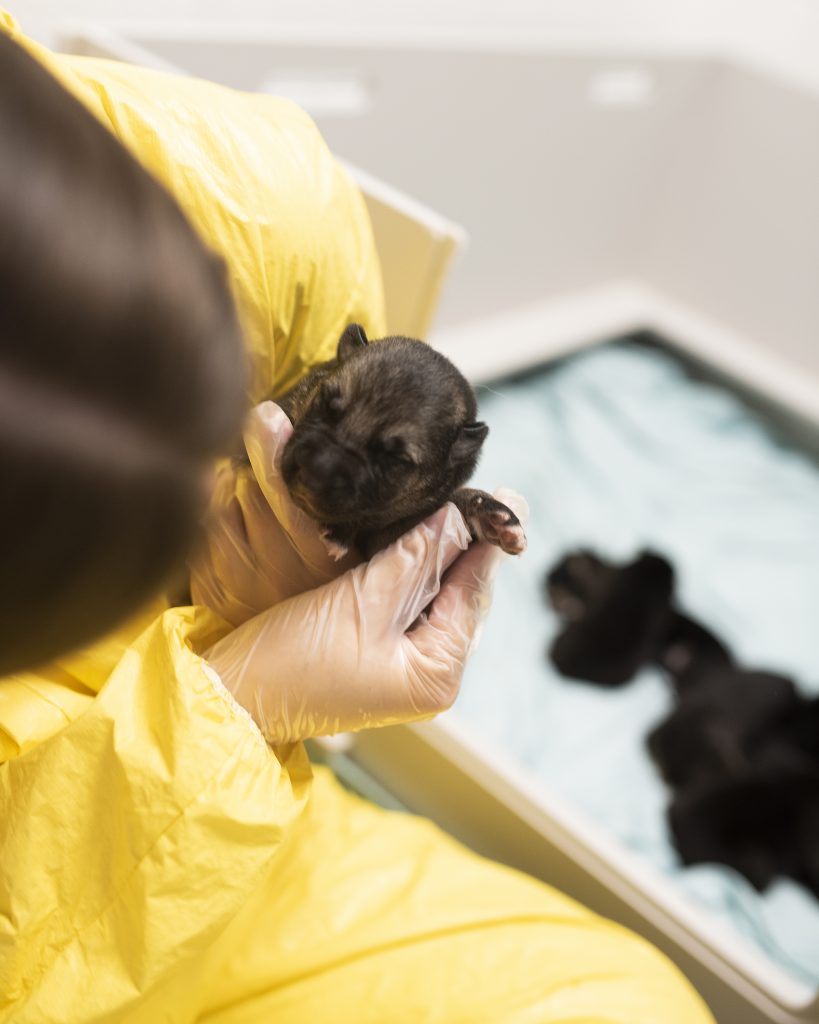Pregnancy and Birthing

How long is a typically dog pregnancy?
The gestation length in dogs (dog pregnancy length) is around 63 days, or just over two months, although it may range from 58-68 days.
Mom’s temperature in the 3 days leading up to birth: Why is this important? About 24 hours before the beginning of labor, there will be a temporary drop in the body temperature. Normal temperature is 101 to 102.5 degrees Fahrenheit. Twenty-four hours prior to labor, the temperature can drop to 98 to 99 F.
How do moms generally act in the day leading up to birth?
You may notice restlessness and anxiety. You may see the dog panting, pacing, refusing food and maybe vomiting. Nesting behavior begins. She may pull at the sides of the sheets underneath the whelping box. Try to keep the sheets as taut as possible to avoid puppies getting stuck when the birthing process starts to happen.
What does healthy dog labor look like?
There are three stages of dog labor. Contractions in the first stage can last 6-12 hours. Puppies are usually born 45-60 minutes apart, but the mother dog may take a break of up to four hours between puppies.
First Stage of Dog Labor: Start of Contractions
The first stage is defined as cervix relaxation and the start of intermittent contractions. However, you are not likely to see the contractions at this point in the birthing process. During this stage, your dog will act restless, travel in and out of the nesting box, pant, dig, and sometimes even vomit. This stage can last as long as 6-12 hours.
Second Stage of Dog Labor: Stronger Contractions and Birth
The second stage of labor begins with stronger, more frequent uterine contractions that eventually lead to the birth of a puppy. Puppies are usually born every 45-60 minutes, with 10-30 minutes of hard straining. Puppies are born in a sac of fluid that mom should immediately break open and eat. Expect some puppies to be born tail first, as this is not abnormal for dogs. It is normal for the mother to take a break during the whelping process, and she may not strain at all for up to four hours in between puppies. It can be very hard to tell when a mom is done vs when she is just taking a break, so she will need to be monitored every so often and checked for signs of continued labor or stress, etc.
*If the dog has been straining for more than 60 minutes, or she takes longer than a four-hour break, she may need to see a veterinarian.

Third Stage of Dog Labor: Afterbirth
The final stage of labor is passing the placenta. You will see a greenish-black mass of fetal membranes (sometimes called “afterbirth”) that is expelled after each puppy is born. Mom should be attentive to the puppies, licking, cleaning, and keeping them warm. If you notice a puppy who is not latching please try to help them latch by placing them close to mom with their mouth on her nipple. Use caution and go slow as new moms can be protective of their new pups. Make sure mom is keeping the pups warm – newborn pups cannot regulate their body temp and must be near mom or other pups for warmth.
Other important birthing information:
When dogs go into labor instincts take over. For the most part you are just there as moral support for the dog. Puppies can be born head or tail first; both are normal. Delivery process can take anywhere between an hour to 24 hours. If labor lasts for four hours with no puppies or between puppies call your vet. Traditionally, a pup is born within 45 to 60 minutes. Puppies are born in a sac. The mother will open the sac and tear the umbilical cord herself. If she does not you should gently open the sac and clean off the puppy. Stillbirths are common for most littered mammals. If you see a puppy that is alive but not breathing try to clear the mouth and rub the body to stimulate the puppy.
Postpartum Care
Mama dogs should be kept on a higher calorie (pregnancy or puppy) diet for as long as she is nursing her puppies. Make sure she has food and fresh water readily available at all times.
Monitor Nursing
Newborn puppies should be nursing every one to two hours, so the mama dog will likely be with them constantly for the first week or two. If you think that the dog may not be producing milk, or isn’t letting the puppies nurse, contact your vet right away.
Call Your Vet if Mama Dog Seems Sick
If the mama dog becomes ill, call your vet immediately and let them know what you have observed. If the dog stops eating, vomits, or becomes very lethargic (weak and tired), or if you notice redness and swelling in any of her mammary glands, contact your vet immediately.
Approach the Puppies With Caution
Use caution when approaching the puppies, as some mothers may show aggression to humans or other household dogs if they perceive a threat. It is very common for even the friendliest of dogs to be protective of their new pups! Watch for “poor doers” or “runts of the litter” (puppies that are much smaller and not growing as quickly as their littermates), as they could have underlying health conditions affecting their ability to grow. If you notice that one of the puppies is smaller or has less energy than the others, consult your vet.
